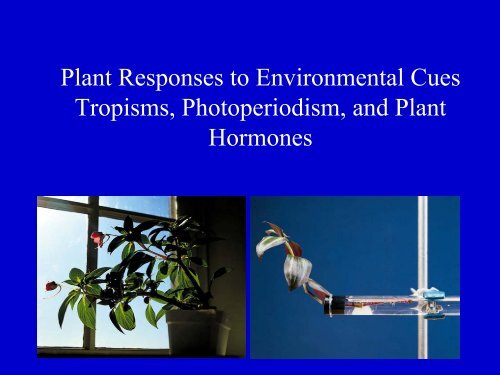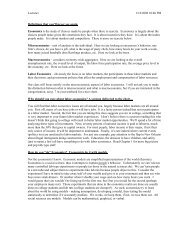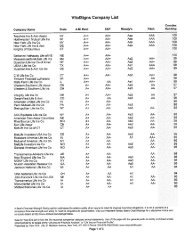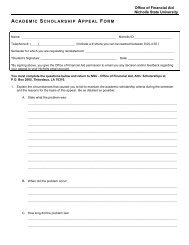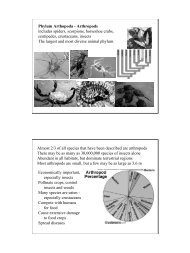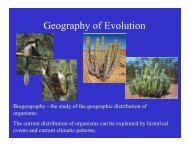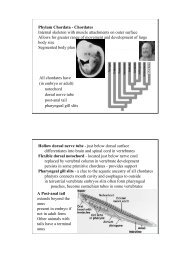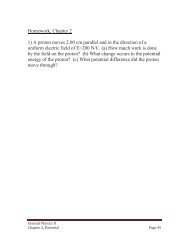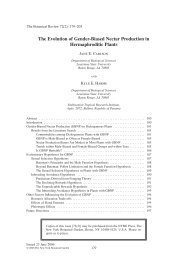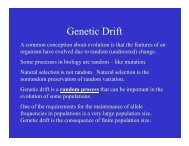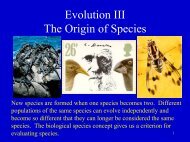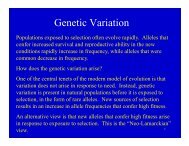Create successful ePaper yourself
Turn your PDF publications into a flip-book with our unique Google optimized e-Paper software.
<strong>Plant</strong> Responses to Environmental Cues<br />
Tropisms, Photoperiodism, and <strong>Plant</strong><br />
<strong>Hormones</strong>
<strong>Plant</strong> Responses to Environmental Cues<br />
Phototropism - plant growth response to light<br />
shoots bend toward light - positive phototropism<br />
roots sometimes bend away from light - negative phototropism<br />
allows shoots to capture more light<br />
mediated by the plant hormone auxin<br />
Gravitropism - plant growth response to gravity<br />
shoots bend away from gravity - negative gravitropism<br />
mediated by auxin - causes lower side of stem to elongate<br />
roots grow toward gravity - positive gravitropism<br />
mediated by gravity sensing cells in root cap<br />
Thigmotropism - plant growth response to touch<br />
causes coiling of tendrils<br />
mediated by auxin and ethylene
Turgor Movement<br />
Turgor is pressure within a living<br />
cell resulting from water<br />
diffusion.<br />
After exposure to a stimulus,<br />
changes in leaf orientation are<br />
mostly associated with rapid<br />
turgor pressure changes in<br />
pulvini - multicellular swellings<br />
located at base of each<br />
leaf or leaflet<br />
turgor movements are reversible
Circadian clocks are endogenous timekeepers that keep plant<br />
responses synchronized with the environment.<br />
circadian rhythm characteristics<br />
• must continue to run in absence of external inputs<br />
• must be about 24 hours in duration<br />
•can be reset or entrained<br />
•can compensate for temperature differences
<strong>Plant</strong> <strong>Hormones</strong><br />
Auxin - indole acetic acid (IAA) - causes stem elongation and<br />
growth - formation of adventitious and lateral roots, inhibits leaf<br />
loss, promotes cell division (with cytokinins), increases ethylene<br />
production, enforces dormancy of lateral buds<br />
produced by shoot apical meristems and other immature parts<br />
Cytokinins - stimulate cell division (with auxin), promote<br />
chloroplast development, delay leaf aging, promote formation of<br />
buds, inhibit formation of lateral roots<br />
produced by root apical meristems and immature fruits<br />
Gibberellins - promote stem elongation, stimulate enzyme<br />
production in germinating seeds<br />
produced by roots and shoot tips, young leaves, seeds
<strong>Plant</strong> <strong>Hormones</strong><br />
Ethylene - controls abscission (shedding) of leaves, flowers, fruits,<br />
promotes fruit ripening<br />
produced by apical meristems, leaf nodes, aging flowers,<br />
ripening fruit<br />
Abscissic acid - inhibits bud growth, controls stomate closing,<br />
enforces seed dormancy, inhibits other hormones<br />
produced by leaves, fruits, root caps, and seeds
Auxin<br />
Responsible for phototropism<br />
Charles and Francis Darwin<br />
wondered what caused plants to<br />
bend toward light<br />
They demonstrated that growing<br />
tips of plants sense light<br />
The ability to sense light is not<br />
present in areas behind the shoot<br />
apex
Went demonstrated that a chemical produced in the shoot tip is<br />
responsible for the shoot bending - he called it “auxin”<br />
An agar block can absorb chemicals below a growing shoot tip<br />
When the block is applied to an immature shoot, the shoot<br />
elongates more on the side where the agar block is applied
Auxin is produced uniformly by growing shoot tips but is<br />
transported to the unlighted side of the shoot<br />
It causes cells on the unlighted side to elongate more than cells on<br />
the lighted side - it does this by making cell walls softer and more<br />
easily stretched by expansion of the cell’s cytoplasm
Other effects of auxins<br />
Stimulates formation of fruits<br />
pollen contains large amounts of auxin - pollen’s auxin is a<br />
chemical signal that pollination has happened and fruit<br />
formation can begin - synthetic auxins can cause fruit<br />
formation without pollination<br />
Addition of synthetic auxins to cuttings stimulates formation of<br />
roots in plant cuttings - “rooting hormone”<br />
Auxin inhibits the growth of lateral buds in shoots -<br />
production of auxin by the shoot apex stops growth of<br />
neighboring lateral buds - “apical dominance”<br />
Synthetic auxins can be used to control weedy dicots through the<br />
inhibition of growth of shoots - it doesn’t harm monocots -<br />
most commonly used synthetic auxin is 2,4D - often used in<br />
lawn “weed and feeds”
Apical Dominance - the tip of a growing shoot (apical bud)<br />
produces auxin that inhibits the growth of lateral buds<br />
below the apical bud
Cytokinins<br />
Produced in root apical meristem and by fruits<br />
Inhibits lateral root growth and stimulates lateral bud growth<br />
The combination of auxin, which inhibits lateral bud growth, and<br />
cytokinin, which stimulates lateral bud growth, produce the<br />
growth form of a plant
Gibberellins<br />
Produced in apical portions of roots and shoots<br />
Cause elongation of internodes in stems (with auxin)
Ethylene<br />
Produced in mature fruit and in some apical meristems<br />
Initial observation of ethylene gas inducing defoliation<br />
Suppresses lateral bud formation when combined with auxin<br />
Suppresses stem and root elongation<br />
Plays major role in ripening of fruit<br />
Fruit forms separation layer at base of leaf petioles<br />
Hastens ripening, increases respiration<br />
Complex carbohydrates broken down into simple sugars<br />
Chlorophylls broken down<br />
Cell walls become soft<br />
Volatile chemicals produced, associated with flavor and scent<br />
of ripe fruit<br />
Ethylene used commercially to ripen green fruits -<br />
Carbon dioxide has opposite effect, fruit is often shipped<br />
in CO2 atmosphere, ethylene applied at destination
Abscissic Acid<br />
Produced by aging leaves and fruits<br />
Application on leaves causes yellow spots and premature aging<br />
May induce formation of winter buds<br />
Suppresses growth of buds and formation of bud “scales” for<br />
protection<br />
Suppresses growth of dormant lateral buds (with ethylene)<br />
Counters effects of gibberellins<br />
Promotes senescence (decline with age) by countering auxin<br />
Causes dormancy of seeds<br />
Controls opening and closing of stomata - produced when plants<br />
are stressed - causes loss of K + from guard cells
Photoperiodism - plant responses to day and/or night length<br />
Long-day plants flower<br />
in the late Spring and<br />
early Summer, when<br />
days are long and nights<br />
are short<br />
Short-day plants flower<br />
in the late Summer and<br />
early Fall, when days are<br />
short and nights are long<br />
A single flash of light<br />
during a long night will<br />
undo the normal effect<br />
of a long night<br />
Long days: 12 - 16 hours, short nights 8-12 hours<br />
Short days: < 14 hours, long nights > 8 hours
Day and night length are often<br />
manipulated in greenhouses to<br />
produce flowering out of season<br />
Poinsettias normally flower in<br />
the Spring when day length is<br />
increasing - they can be grown<br />
indoors under artificial lighting<br />
that mimics the light conditions<br />
of Spring, just in time for<br />
Christmas
Chemical Basis of the Photoperiodic Response<br />
Two light wavelengths important in the response<br />
Red 660 nm<br />
Far-red 703 nm<br />
Chemistry: two forms of phytochrome: Pr and Pfr<br />
Pfr is biologically active, Pr is biologically inactive<br />
Pr absorbs red light, converted quickly to Pfr , during day<br />
Pfr absorbs far-red light and is converted slowly to Pr, at night<br />
Low concentrations of Pfr indicate a long night (short day)<br />
induces flowering in short-day plants,<br />
suppresses flowering in long-day plants<br />
High concentrations of Pfr indicate a short night (long day)<br />
induces flowering in long-day plants,<br />
suppresses flowering in short-day plants<br />
In a short day plant, a single flash of red light converts Pr to Pfr<br />
and flowering is suppressed
day<br />
[P fr ] [P r ]<br />
High<br />
night<br />
Low<br />
Low<br />
High<br />
High<br />
Low<br />
There must be a lengthy and continuous period of darkness<br />
for Pfr concentrations to become low


